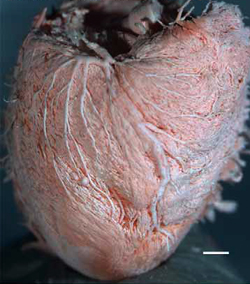Empty heart, new heart
The research: Lab-made hearts are now a reality. Researchers at the University of Minnesota were able to create new hearts almost from scratch. First, the researchers remove all preexisting cells from a rat heart using detergents (a process called decellularization). Then, they refill the remaining gelatinous scaffold with rat neonatal cardiac cells. The new heart starts contracting four days later. After 8 days, the lab-made hearts pump up to 2% of a normal adult heart.
Advantages: The final step in heart failure patients is organ transplantation. However, a transplanted patient should be treated for life with immune suppressors to avoid the body’s natural rejection towards the foreign organ. Now, researchers envision a future where they could build a heart using the patients’ own cells on biological scaffold. The technique may help reduce the immune response to foreign tissue.
Why it matters: Heart failure affects about 5 million Americans and causes more than 57,000 deaths each year, according to the American Heart Association. Çardiovascular disease killed 16.7 million people (29.2% of total all deaths), according to a 2003 World Health Organization report. By 2010, cardiovascular disease will be the leading cause of death in developing countries.
Next steps: Scientists have successfully decellularized pig hearts, which are as big and complex as human ones. They are also working on other organs such as liver and kidney. Future research is focus on developing strategies for improving heart pumping efficiency. The authors believe this technique could be used in humans in less than 10 years.
“Perfusion-decellularized matrix: using nature's platform to engineer a bioartificial heart.”






